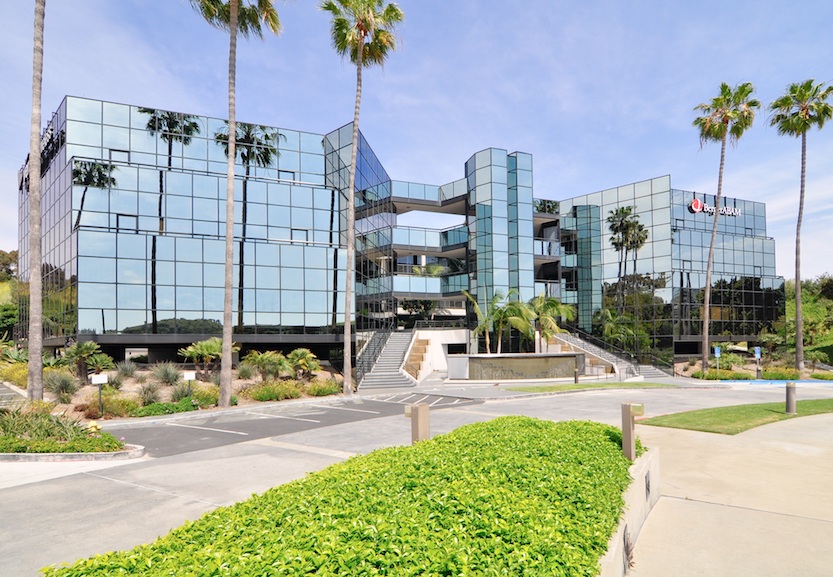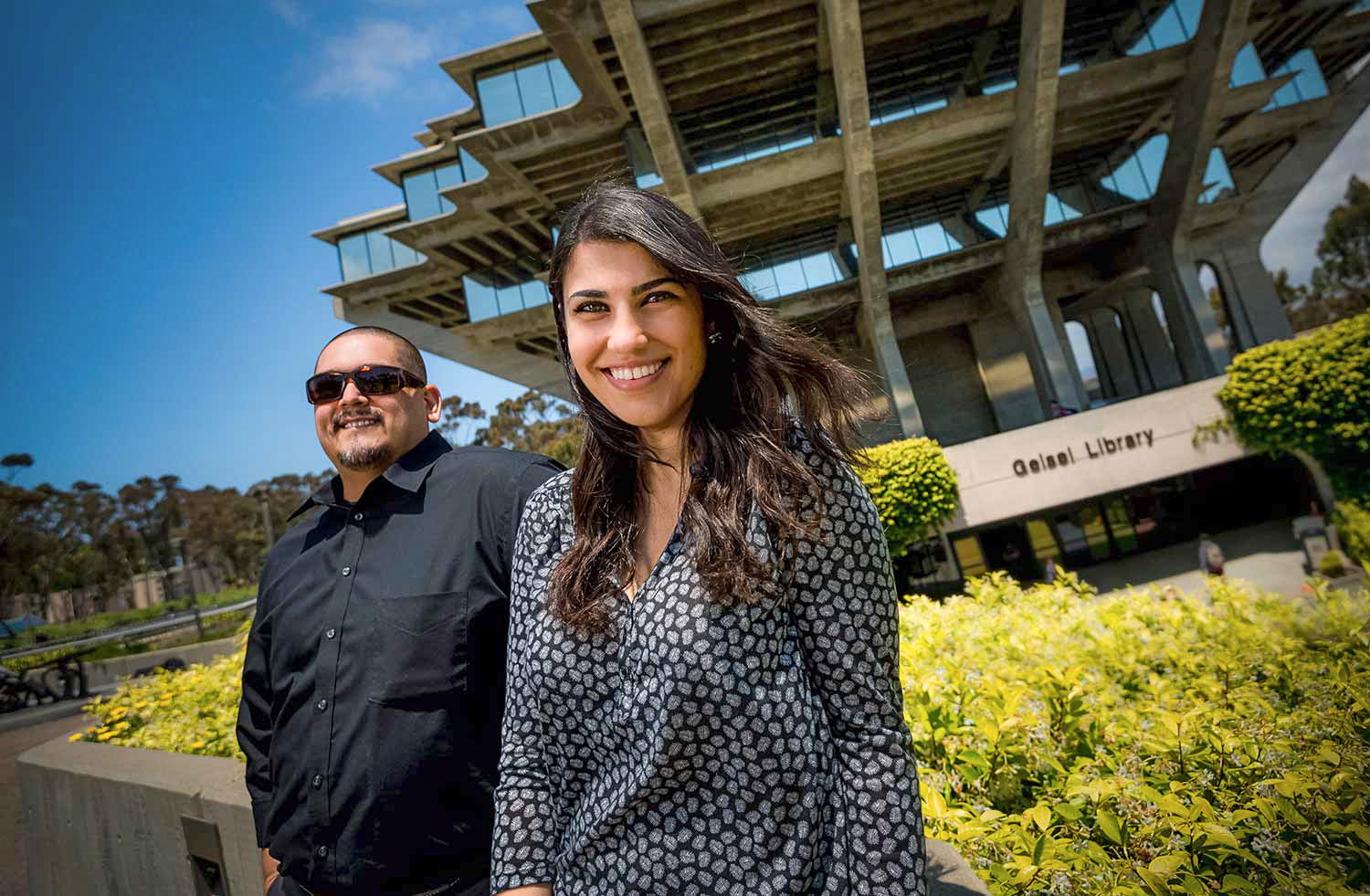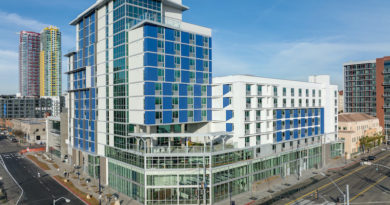Daily Business Report-Aug. 11, 2017
TSRI ranks number one, above other internationally renowned research institutes.
TSRI Ranked Most Influential
Research Institution in the World
The Scripps Research Institute (TSRI) is the most influential research institution in the world, according to the Nature Index 2017 Innovation supplement, which sheds light on the impact of academic research on innovation. The ranking, released by the journal Nature, analyzes data about research quality and the broad influence it has on inventions.
“This new ranking underscores the worldwide impact of TSRI scientists, who share a common goal of improving public health through scientific discovery, and, importantly, improving the way we make those discoveries,” said Jamie Williamson, TSRI’s Executive Vice President for Research and Academic Affairs. “We are proud to be recognized for the profound influence our science has had on other researchers and laboratories around the world.”
The Normalized Lens Influence Metric used by the Nature Index measures the influence an institution’s research has had on innovation by calculating the citations of its research articles in patents owned by third parties, rather than those owned by institutions themselves.
According to this metric, TSRI ranks number one, above other internationally renowned research institutes such as the Rockefeller University in New York, the Massachusetts Institute of Technology and Stanford University.
Read more…
____________________

A Later Start to the School Day?
Why California Could Delay the Bell
By Jessica Calefati | CALmatters
Coaxing groggy teenagers out of bed and onto an early morning school bus is a challenge for many parents.
Democratic state Sen. Anthony Portantino of La Cañada Flintridge says you can count him among them.

He’s struggled to get his own sleepy teenage daughter up and out the door on school days, and now he’s carrying Senate Bill 328, which would make California the first state in the nation to prohibit public middle and high schools from starting first period any earlier than 8:30 a.m.
“If we want healthy kids and healthy schools, we should have a healthy start time based on science, biology and results,” Portantino said.
Research shows two-thirds of adolescents aren’t getting enough sleep and that the consequences are far-reaching. The onset of puberty triggers changes in the body’s circadian rhythms, and the result, notes the National Sleep Foundation, is that that the typical high schooler’s natural time to fall asleep shifts to 11 p.m. or later. Sleepy teens are more likely to slip into depression or use drugs and less likely to graduate from high school.
But there’s disagreement on the best way to address the problem.
Some observers say parents need to buckle down and impose stricter bedtimes, while others, like the American Academy of Pediatrics, point to a “substantial body of research” showing that later school start times alone can reverse the negative effects of sleep deprivation among teens.
Currently, California schools are free to begin the school day whenever they’d like, and only one in five middle and high schools start as late as Portantino’s bill would require. Many also host sports practices and offer “zero period” classes before the school day technically begins, although the bill would not prohibit these early options.
Opponents such as the California School Boards Association say SB 328 would wreak havoc on working parents’ schedules and cause districts’ transportation costs to skyrocket.
Still, Portantino says he’s siding with science and calls the proposal a response to a “public health crisis” that California shouldn’t ignore.
“Schools can’t use ceiling tiles with asbestos because we know it causes cancer. They can’t put lead paint on the walls because we know it causes brain damage. And we shouldn’t let them start school so early when we know it leaves our children sleep-deprived,” Portantino said.
The value of a good night’s sleep isn’t in dispute, said Nancy Chaires Espinoza, a lobbyist for the California School Boards Association, the measure’s biggest critic.
“We recognize the importance of sleep. Of course we do. And we don’t oppose later school start times,” Chaires Espinoza said. “We oppose this bill because we don’t think a one-size-fits-all approach will result in kids getting any more rest.”
Chaires Espinoza predicts that most parents won’t be able to modify their work schedules to accommodate the policy change and that they’ll wind up dropping off their children around the same time they do now, regardless of whether school is in session.
The California State PTA, however, supports the bill.
Flipping the busing schedule so that young children who naturally shoot up out of bed early get driven to school first isn’t cost prohibitive, but it wouldn’t work either, she said. That would require sending kids to elementary school in the dark for part of the year—something parents oppose.
She also rejected the applicability of research frequently cited by Portantino as proof of his proposal’s value, noting that the 2014 study, authored by University of Minnesota researcher Kyla Wahlstrom, wasn’t conducted in California.
The study tracked 9,000 students attending eight public high schools in three different states and found that when schools start later than 8:30 a.m., more than 60 percent of students are able to get at least eight hours of sleep. Those students report fewer signs of depression, less caffeine use, better grades, higher standardized test scores and fewer absences.
And when schools shifted their start times from 7:35 a.m. to 8:55 a.m., the number of car crashes involving teen drivers ages 16 to 18 dropped by 70 percent, the study found.
“The health benefits and the reduction in risky behavior are clear,” Wahlstrom said. “Whether the public health arguments outweigh the local control arguments is for the Legislature to decide.”
The short-term benefits of later school start times may be well documented, but the long-term benefits are more murky, say Ian Campbell and Irwin Feinberg, University of California at Davis researchers who study adolescent sleep and warn that Portantino’s promises about what the bill can do may not pan out.
They pointed to a 2016 study that examined the impact of a New York high school’s delayed start over several years and found that the increases in sleep that students experienced at first dissipated over time as they gradually pushed back their bedtimes. Sleepiness among adolescents may also be a function of biology, they said.
“It would be reckless to make such a sweeping change without the evidence to back it up, and we find the evidence in this case to be pretty weak,” said Feinberg, who called the American Academy of Pediatrics’ recommendation “premature.”
SB 328 has already cleared the state Senate and will be taken up by the Assembly Appropriations Committee when lawmakers return from summer recess later this month.
Gov. Jerry Brown hasn’t commented on the legislation, but given his penchant for local control, some observers say he’s unlikely to support the measure should it reach his desk.
CALmatters.org is a nonprofit, nonpartisan media venture explaining California policies and politics.
____________________

Construction Underway on New
Palomar Health Outpatient Center
Construction is underway on Palomar Health Outpatient Center I, the 75,000-square-foot first-phase of a three-phase 225,000-square-foot Class A medical office development located on-campus at Palomar Medical Center Escondido.
When completed, Palomar Health’s Outpatient Center will represent the nearest medical office building to the Palomar Medical Center Escondido Hospital, a 740,000-square-foot, 11-story hospital facility that opened in 2012
Located on Citracado Parkway, the new OPC campus is a development of ERTC Medical Office Development I, L.P./JRMC Real Estate Inc. The team includes campus architect/designer Richard Yen & Associates with general contractor Level 10 Construction. Cushman & Wakefield is handling project leasing on behalf of the owner.
Completion of Palomar Health Outpatient Center Phase-1 is slated for the second quarter of 2018.
____________________

Premier Realty Holdings Acquires
Wateridge Pavilion for $16.3 Million
Premier Realty Holdings Inc. has acquired Wateridge Pavilion from Fenway Properties for $16.3 million. Located at 10525 Vista Sorrento Parkway in the Sorrento Mesa area, the three-story, 62,427-square-foot office building was 97 percent leased at the time of sale.
San Diego-based Premier Realty Holdings, a private investment firm led by Marc Barmazel, plans to occupy space at Wateridge Pavilion.
CBRE and Cushman & Wakefield handled the transaction on behalf of the seller and buyer.
____________________
County Releases Draft Climate
Action Plan for Public Comment
The county of San Diego Thursday released a draft Climate Action Plan for a 45-day public comment period scheduled to end Sept. 25.
The draft plan is designed to cut greenhouse gases in the county’s unincorporated communities as well as those related to county government operations. It seeks to meet state requirements with actions that balance environmental, economic and community interests, while taking into account the County’s largely rural character.
Both the draft plan and its draft supplemental environmental impact report can be reviewed on the County Planning & Development Services Climate Action Plan web page. http://www.sandiegocounty.gov/pds/advance/climateactionplan.html
After the 45-day public review and comment period ends, the San Diego County Planning Commission and the San Diego County Board of Supervisors will hold hearings in early 2018.
The draft plan was created with input from local residents and more than 50 stakeholder groups, ranging from environmental to business and community organizations, collected in more than 100 public workshops, meetings and events.
For more information about the draft plan, go to the Planning & Development Services Climate Action Plan web page. Written comments on the draft documents can be submitted to CAP@sdcounty.ca.gov.
____________________

Personnel Announcements
Brian Roberts Reappointed to Board of Parole Hearings

Brian Roberts, 65, of Santee, has been reappointed to the Board of Parole Hearings by Gov. Jerry Brown. Roberts has served on the board since 2012 and was a deputy commissioner from 2006 to 2012.
Roberts served in several positions at the San Diego County Sheriff’s Department from 1975 to 2006, including commander, captain, lieutenant, sergeant and deputy. The position requires Senate confirmation and the compensation is $147,778. Roberts is a Republican.
____________________
Commentary
Busting the Myth That Proposition 13
Eviscerated San Diego’s Tax Revenue
By Robert Gutierrez
The year 1978 might seem almost like ancient history — a distant memory for most voters, and unimaginable for a growing class of policymakers who were not yet born then. With the passage of time, folklore prevails and myths sometimes come to overshadow facts. It is in this light that opponents of Proposition 13 have made many false claims about the landmark property tax reform initiative.
One of the often-cited claims by opponents of the 1978 ballot measure is that “Proposition 13 eviscerated local revenue.” Nothing could be further from the facts. Data shows that since 1978, local property tax assessments in California have increased by 856.48 percent.
This year alone, local property tax assessments are expected to increase an average of 5.5 percent statewide, amounting to billions of dollars in additional funding for local schools, libraries, fire and police departments, parks and recreation programs, public health programs, streets and transit.
San Diego County alone has seen 6.05 percent growth in the total assessed value of properties subject to local property tax. In comparison, Los Angeles County’s assessment roll grew 6.03 percent, and Orange County’s grew 6.02 percent.
While Proposition 13 limits property taxes to 1 percent of a property’s assessed value, and caps how fast taxes can increase each year, the aggregate revenue growth has been substantial.
Proposition 13 protects property owners by capping the growth of a property’s assessed value to 2 percent per year, absent a change in ownership or new construction. The point that many critics of Proposition 13 fail to account for is that aggregate figures are much higher than 2 percent. Only in the depths of the state’s worst recessions (1994-1996 and 2009-2012) have Proposition 13 property taxes failed to grow more than 2 percent per year.
In fact, the growth of property tax assessments has far outpaced inflation and changes in California’s population. Since passage of Proposition 13, assessments have grown at an average rate of about 7.07 percent per year. In contrast, inflation has grown at an average annual rate of 3.57 percent, and population has grown at an average rate of 1.43 percent.
The post-Proposition 13 growth is similar to the growth prior to the initiative’s passage. From 1945-46 to 1977-78, property assessments grew at an average rate of 7.93 percent.
What most people remember from the pre-Proposition 13 period is the public outrage, as property tax assessments were skyrocketing as much as 15 percent from one year to the next, based on such things as the sale price of your neighbor’s house.
Instead of setting your property tax based on factors out of your control, Proposition 13 bases the property tax on acquisition value – usually the purchase price, an objective standard that generally is not disputed – plus 2 percent per year. The cap ensures that even as the aggregate property tax assessments grow, individual taxpayers are protected.
Discussions about Proposition 13 should not be framed by myths and misleading statements. To evaluate Proposition 13, tangible data from state and local sources must be used to inform the debate.
Love Proposition 13 or hate it, the data shows that it has provided a stable and growing source of revenue for local government that has far exceeded inflation.

Robert Gutierrez is director of the California Tax Foundation, a nonprofit organization funded through grants and donations from taxpayers. The foundation is online at caltaxfoundation.org.




